MAZDA MODEL CX-5 2018 Owners Manual (in English)
Manufacturer: MAZDA, Model Year: 2018, Model line: MODEL CX-5, Model: MAZDA MODEL CX-5 2018Pages: 628, PDF Size: 82.38 MB
Page 221 of 628
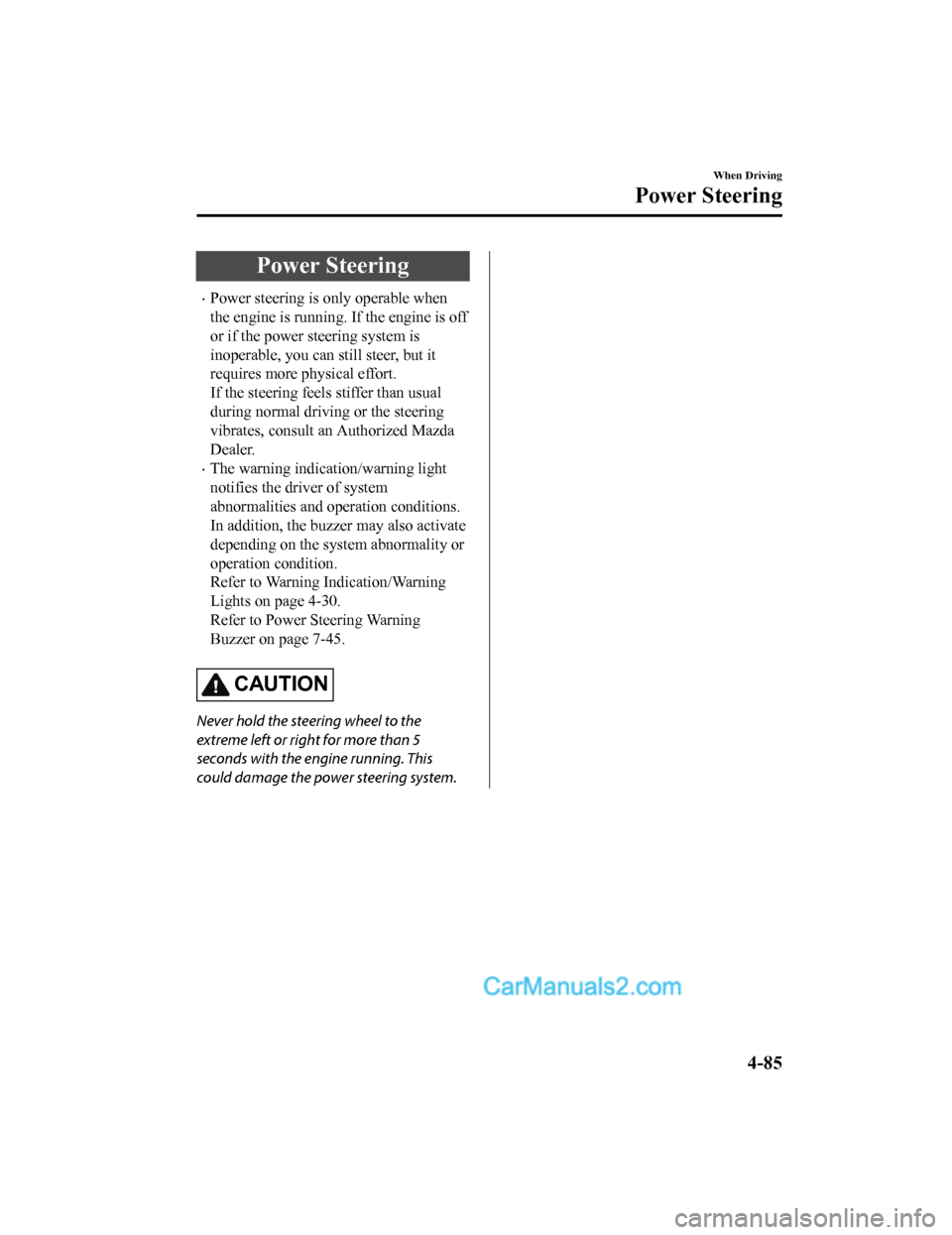
Power Steering
•Power steering is only operable when
the engine is running. If the engine is off
or if the power steering system is
inoperable, you can still steer, but it
requires more physical effort.
If the steering feels stiffer than usual
during normal driving or the steering
vibrates, consult an Authorized Mazda
Dealer.
•The warning indication/warning light
notifies the driver of system
abnormalities and operation conditions.
In addition, the buzzer may also activate
depending on the system abnormality or
operation condition.
Refer to Warning Indication/Warning
Lights on page 4-30.
Refer to Power Steering Warning
Buzzer on page 7-45.
CAUTION
Never hold the steering wheel to the
extreme left or right for more than 5
seconds with the engine running. This
could damage the power steering system.
When Driving
Power Steering
4-85
CX-5_8GN5-EA-17J_Edition12017-8-18 12:58:27
Page 222 of 628
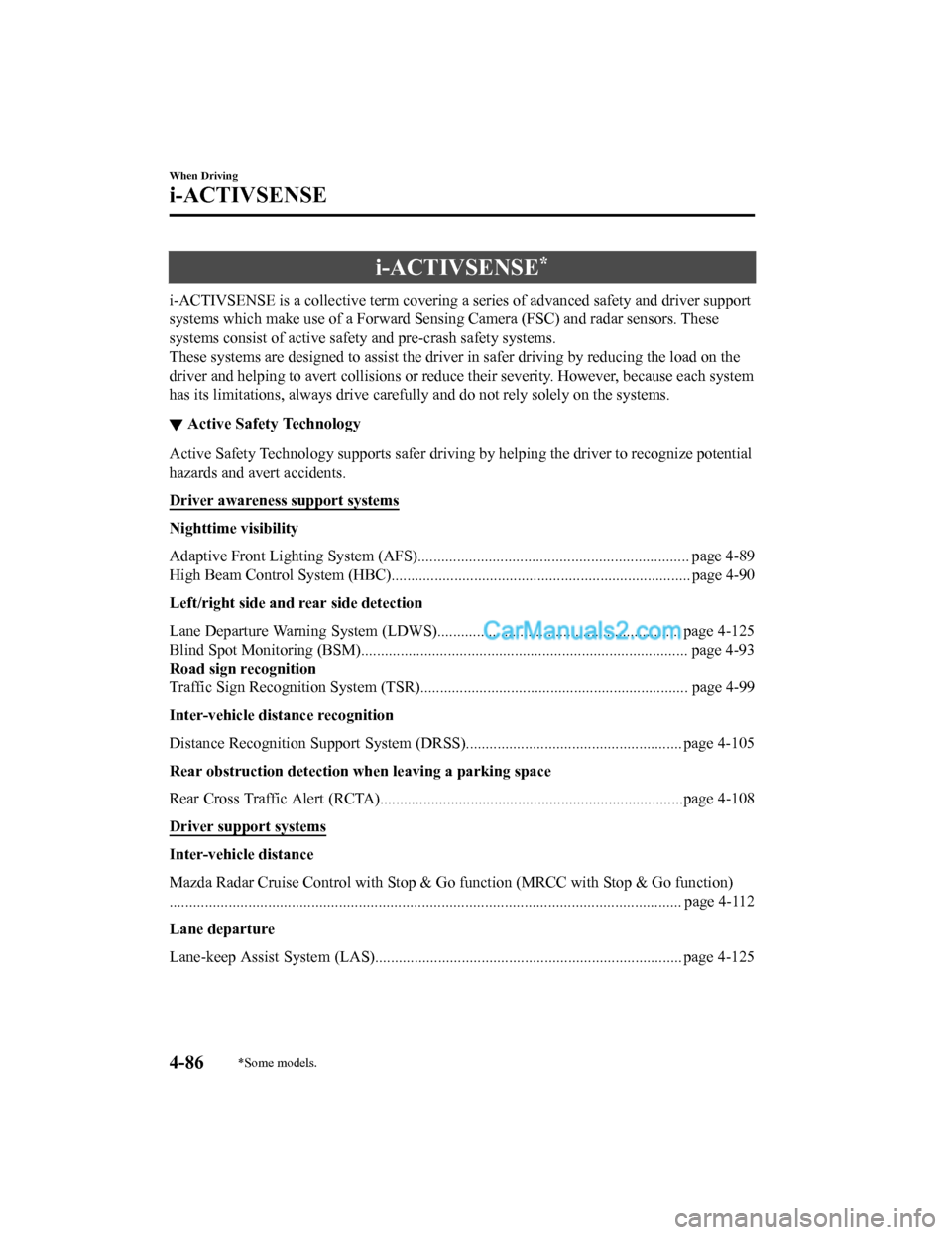
i-ACTIVSENSE*
i-ACTIVSENSE is a collective term covering a series of advanced safety and driver support
systems which make use of a Forw ard Sensing Camera (FSC) and radar sensors. These
systems consist of active safety and pre-crash safety systems.
These systems are designed to ass ist the driver in safer driving by reducing the load on the
driver and helping to avert col lisions or reduce their severity. However, because each system
has its limitations, always drive carefully and do not rely sol ely on the systems.
▼Active Safety Technology
Active Safety Technology supports safer driving by helping the
driver to recognize potential
hazards and avert accidents.
Driver awareness support systems
Nighttime visibility
Adaptive Front Lighting Sy stem (AFS)..................................................................... page 4-89
High Beam Control System (HBC)................................. ........................................... page 4-90
Left/right side and rear side detection
Lane Departure Warning Sys tem (LDWS).............................................................. page 4-125
Blind Spot Monitoring (BSM)................................................................................... page 4-93
Road sign recognition
Traffic Sign Recogn ition System (TSR).......................... .......................................... page 4-99
Inter-vehicle distance recognition
Distance Recognition Support System (DRSS)....................................................... page 4-105
Rear obstruction detection wh en leaving a parking space
Rear Cross Traffic Alert (RCTA)................................ .............................................page 4-108
Driver support systems
Inter-vehicle distance
Mazda Radar Cruise Control with S top & Go function (MRCC with Stop & Go function)
.................................................................................................................................. page 4-112
Lane departure
Lane-keep Assist System (LAS).................................. ............................................ page 4-125
When Driving
i-ACTIVSENSE
4-86*Some models.
CX-5_8GN5-EA-17J_Edition1 2017-8-18 12:58:27
Page 223 of 628
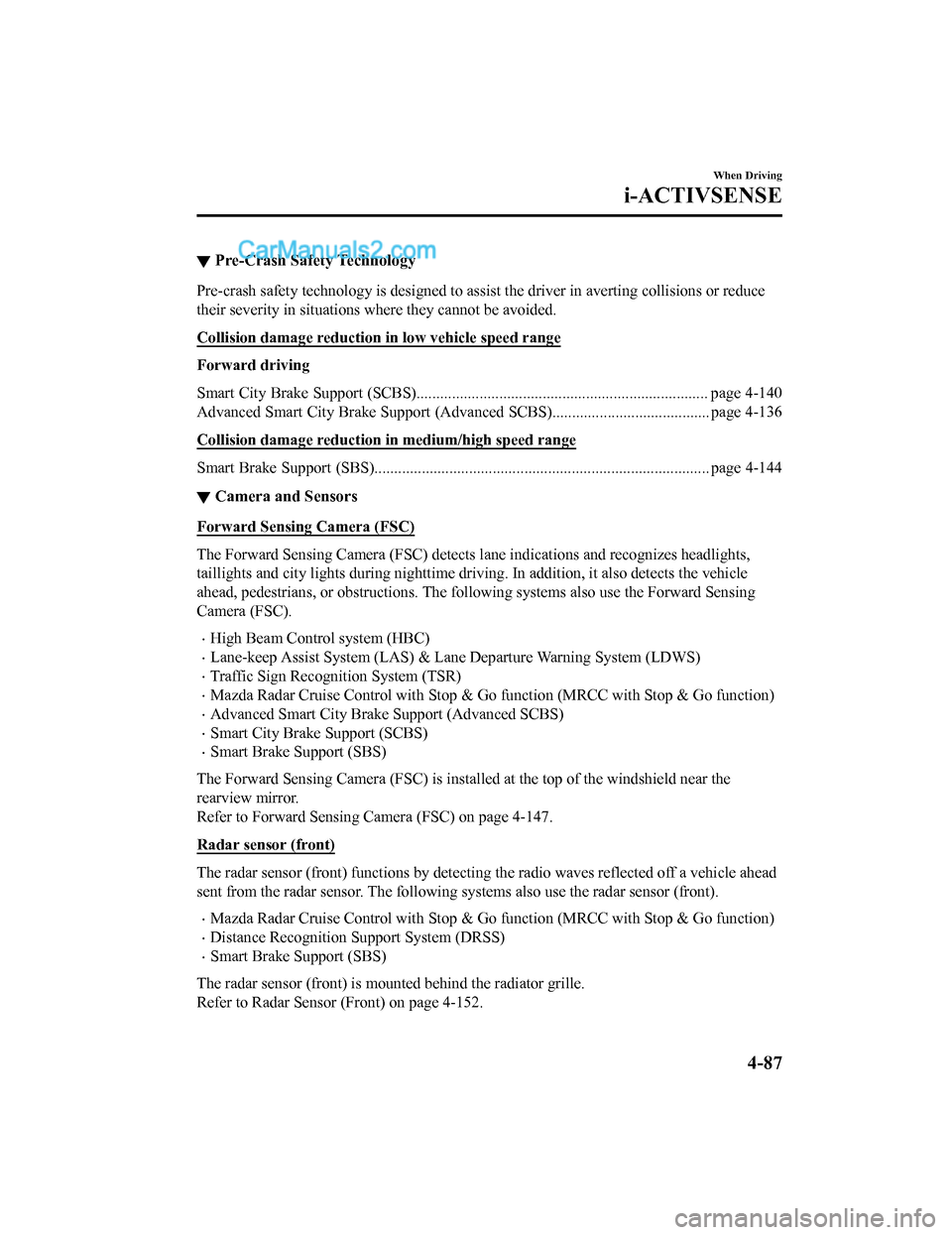
▼Pre-Crash Safety Technology
Pre-crash safety technology is de
signed to assist the driver in averting collisions or reduce
their severity in situations where they cannot be avoided.
Collision damage reduction in low vehicle speed range
Forward driving
Smart City Brake Support (SCBS)................................ .......................................... page 4-140
Advanced Smart City Brake Support (Advanced SCBS).............. .......................... page 4-136
Collision damage reduction in medium/high speed range
Smart Brake Support (SBS)...................................... ............................................... page 4-144
▼Camera and Sensors
Forward Sensing Camera (FSC)
The Forward Sensing Camera (FSC) detects lane indications and recognizes headlights,
taillights and city lights during
nighttime driving. In addition, it also detects the vehicle
ahead, pedestrians, or obstructi ons. The following systems also use the Forward Sensing
Camera (FSC).
•High Beam Control system (HBC)
•Lane-keep Assist System (LAS) & Lane Departure Warning System ( LDWS)
•Traffic Sign Recognition System (TSR)
•Mazda Radar Cruise Control with Stop & Go function (MRCC with S top & Go function)
•Advanced Smart City Brake Support (Advanced SCBS)
•Smart City Brake Support (SCBS)
•Smart Brake Support (SBS)
The Forward Sensing Camera (FSC) is installed at the top of the windshield near the
rearview mirror.
Refer to Forward Sensing Camera (FSC) on page 4-147.
Radar sensor (front)
The radar sensor (front) functions by detecting the radio waves reflected off a vehicle ahead
sent from the radar sensor. The following systems also use the radar sensor (front).
•Mazda Radar Cruise Control with Stop & Go function (MRCC with S top & Go function)
•Distance Recognition Support System (DRSS)
•Smart Brake Support (SBS)
The radar sensor (front) is mount ed behind the radiator grille.
Refer to Radar Sensor (Front) on page 4-152.
When Driving
i-ACTIVSENSE
4-87
CX-5_8GN5-EA-17J_Edition1 2017-8-18 12:58:27
Page 224 of 628

Radar sensors (rear)
The radar sensors (rear) function by detecting the radio waves reflected off a vehicle
approaching from the rear or an obstruction sent from the radar sensors. The following
systems also use the radar sensors (rear).
•Blind Spot Monitoring (BSM)
•Rear Cross Traffic Alert (RCTA)
The radar sensors (rear) are inst alled inside the rear bumper, one each on the left and right
sides.
Refer to Radar S ensors (Rear) on page 4-155.
When Driving
i-ACTIVSENSE
4-88
CX-5_8GN5-EA-17J_Edition1 2017-8-18 12:58:27
Page 225 of 628

Adaptive Front Lighting System (AFS)*
The adaptive front lighting system (AFS) automatically adjusts the headlight beams to the
left or right in conjunction with the operation of the steering wheel after the headlights have
been turned on.
A system malfunction or operation conditions are indicated by a warning.
Refer to Warning/Indicator Lights on page 4-30.
NOTE
The Adaptive Front Lighting System (AFS) func tion can be switched to operable/inoperable
using the personalization function.
Refer to Personalization Features on page 9-9.
When Driving
i-ACTIVSENSE
*Some models.4-89
CX-5_8GN5-EA-17J_Edition1 2017-8-18 12:58:27
Page 226 of 628
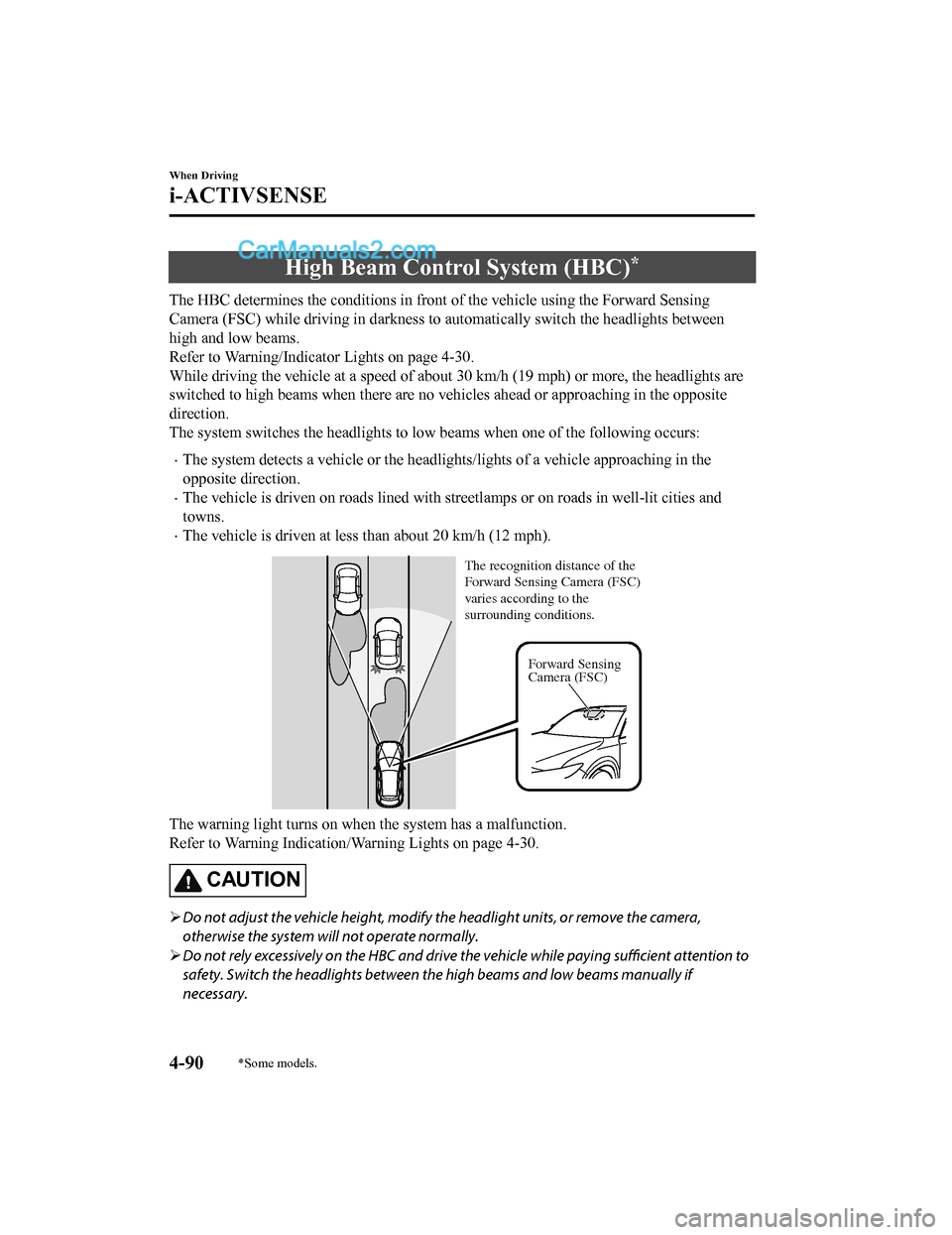
High Beam Control System (HBC)*
The HBC determines the conditions in front of the vehicle using the Forward Sensing
Camera (FSC) while driving in darkness to automatically switch the headlights between
high and low beams.
Refer to Warning/Indicator Lights on page 4-30.
While driving the vehicle at a speed of about 30 km/h (19 mph) or more, the headlights are
switched to high beams when there are no vehicles ahead or appr oaching in the opposite
direction.
The system switches the headlight s to low beams when one of the following occurs:
•The system detects a vehicle or the headlights/lights of a vehi cle approaching in the
opposite direction.
•The vehicle is driven on roads lined with streetlamps or on roa ds in well-lit cities and
towns.
•The vehicle is driven at less than about 20 km/h (12 mph).
Forward Sensing
Camera (FSC)
The recognition distance of the
Forward Sensing Camera (FSC)
varies according to the
surrounding conditions.
The warning light turns on when the system has a malfunction.
Refer to Warning Indication/Warning Lights on page 4-30.
CAUTION
Do not adjust the vehicle height, modify th e headlight units, or remove the camera,
otherwise the system will not operate normally.
Do not rely excessively on the HBC and drive the vehicle while paying
sufficient attention to
safety. Switch the headlights between the high beams and low beams manually if
necessary.
When Driving
i-ACTIVSENSE
4-90*Some models.
CX-5_8GN5-EA-17J_Edition1 2017-8-18 12:58:27
Page 227 of 628
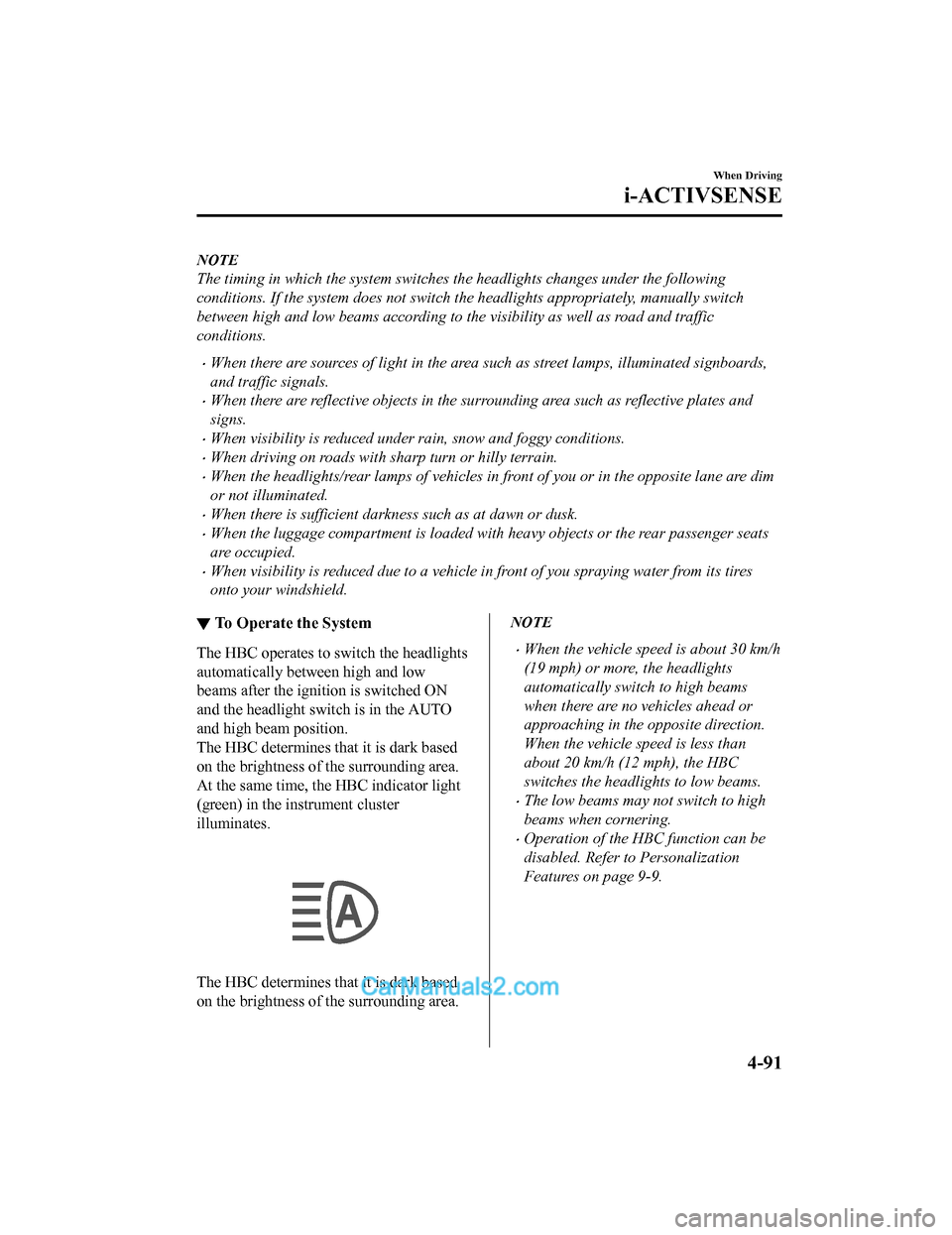
NOTE
The timing in which the system switches the headlights changes under the following
conditions. If the system does not switch the headlights appropriately, manually switch
between high and low beams according to the visibility as well as road and traffic
conditions.
•When there are sources of light in the area such as street lamps, illuminated signboards,
and traffic signals.
•When there are reflective objects in the surrounding area such as reflective plates and
signs.
•When visibility is reduced under rain, snow and foggy conditions.
•When driving on roads with sharp turn or hilly terrain.
•When the headlights/rear lamps of vehicles in front of you or in the opposite lane are dim
or not illuminated.
•When there is sufficient darkness such as at dawn or dusk.
•When the luggage compartment is loaded with heavy objects or the rear passenger seats
are occupied.
•When visibility is reduced due to a vehicle in front of you spraying water from its tires
onto your windshield.
▼ To Operate the System
The HBC operates to s
witch the headlights
automatically between high and low
beams after the igni tion is switched ON
and the headlight sw itch is in the AUTO
and high beam position.
The HBC determines that it is dark based
on the brightness of the surrounding area.
At the same time, the HBC indicator light
(green) in the instrument cluster
illuminates.
The HBC determines that it is dark based
on the brightness of the surrounding area.
NOTE
•When the vehicle speed is about 30 km/h
(19 mph) or more, the headlights
automatically switch to high beams
when there are no vehicles ahead or
approaching in the opposite direction.
When the vehicle speed is less than
about 20 km/h (12 mph), the HBC
switches the headlights to low beams.
•The low beams may not switch to high
beams when cornering.
•Operation of the HBC function can be
disabled. Refer to Personalization
Features on page 9-9.
When Driving
i-ACTIVSENSE
4-91
CX-5_8GN5-EA-17J_Edition1 2017-8-18 12:58:27
Page 228 of 628
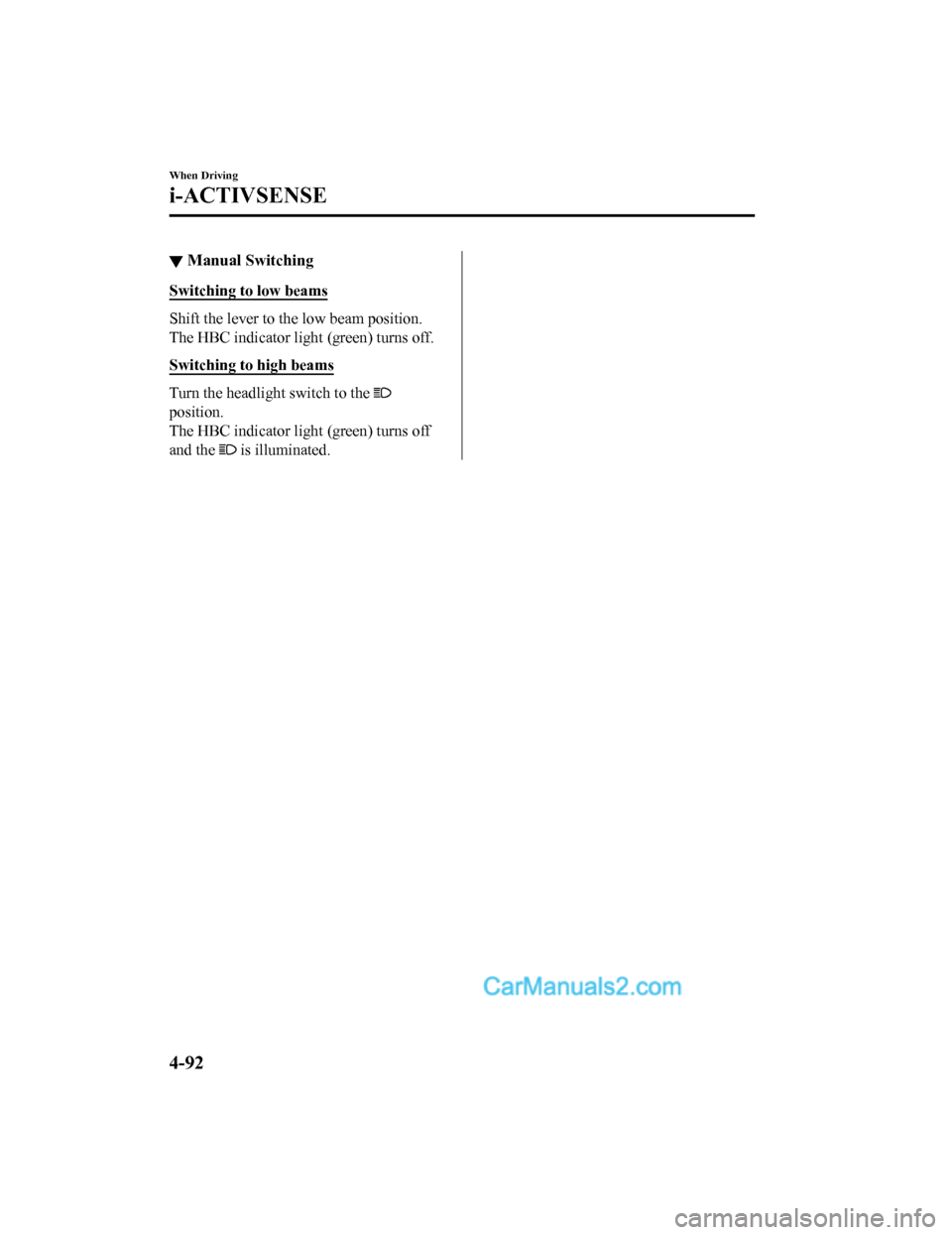
▼Manual Switching
Switching to low beams
Shift the lever to th
e low beam position.
The HBC indicator ligh t (green) turns off.
Switching to high beams
Turn the headlight switch to the
position.
The HBC indicator ligh t (green) turns off
and the
is illuminated.
When Driving
i-ACTIVSENSE
4-92
CX-5_8GN5-EA-17J_Edition1 2017-8-18 12:58:27
Page 229 of 628

Blind Spot Monitoring (BSM)*
The BSM is designed to assist the driver in checking the area to the rear of the vehicle on
both sides during lane changes by notifying the driver of the p resence of vehicles
approaching from the rear in an adjacent lane.
The BSM detects vehicles approaching from the rear while travel ing in the forward
direction at a speed of 10 km/h (6.3 mph) or faster and notifie s the driver by turning on the
BSM warning indicator light and displaying the vehicle detectio n screen (vehicles with
multi-information display and active driving display).
If the turn signal lever is operated to signal a turn in the direction in which the BSM
warning indicator light is illumi nated while the approaching vehicle is detected, the BSM
notifies the driver of possible danger by turning on the BSM wa rning indicator light, and by
activating the warning sound and the warning screen indicator display (vehicles with
multi-information display and active driving display).
The detection area on this system covers the driving lanes on b oth sides of the vehicle and
from the rear part of the front d oors to about 50 m (164 ft) behind the vehicle.
Detection areas
Your vehicle
WA R N I N G
Always check the surrounding area visually before making an actual lane change:
The system is only designed to assist you in checking for vehicles at your rear when making a
lane change. Due to certain limitations with
the operation of this system, the BSM warning
indicator light, the warning sound and the warning screen indicator display may not activate
or they might be delayed even though a vehicle is in an adjacent driving lane. Always make it
your responsibility as a driver to check the rear.
When Driving
i-ACTIVSENSE
*Some models.4-93
CX-5_8GN5-EA-17J_Edition1 2017-8-18 12:58:27
Page 230 of 628

NOTE
•The BSM will operate when all of the following conditions are met:
•The ignition is switched ON.
•The BSM OFF indicator light in the instrument cluster is turned off.
•The vehicle speed is about 10 km/h (6.3 mph) or faster.
•The BSM will not operate under the following circumstances.
•The vehicle speed falls below about 10 km/h (6.3 mph) even though the BSM OFF
indicator light is turned off.
•The selector lever is shifted to r everse (R) and the vehicle is reversing.
•The turning radius is small (making a sharp turn, turning at intersections).
•In the following cases, the BSM OFF indicator light turns on and operation of the system
is stopped. If the BSM OFF indicator light re mains illuminated, have the vehicle inspected
at an Authorized Mazda Dealer as soon as possible.
•Some problem with the system including the BSM warning indicator lights is detected.
•A large deviation in the installation position of a radar sensor (rear) on the vehicle has
occurred.
•There is a large accumulation of snow or ice on the rear bumper near a radar sensor
(rear). Remove any snow, ice or mud on the rear bumper.
•Driving on snow-covered roads for long periods.
•The temperature near the radar sensors (rear) becomes extremely hot due to driving for
long periods on slopes during the summer.
•The battery voltage has decreased.
•Under the following conditions, the radar sensors (rear) cannot detect target objects or it
may be difficult to detect them.
•A vehicle is in the detection area at the rear in an adjacent driving lane but it does not
approach. The BSM determines the condition based on radar detection data.
•A vehicle is traveling alongside your vehicle at nearly the same speed for an extended
period of time.
•Vehicles approaching in the opposite direction.
•A vehicle in an adjacent driving lane is attempting to pass your vehicle.
•A vehicle is in an adjacent lane on a road with extremely wide driving lanes. The
detection area of the radar sensors (rear) is set at the road width of expressways.
•In the following case, the flashing of the BS M warning indicator light, and the activation
of the warning sound and the warning screen indicator display may not occur or they may
be delayed.
•A vehicle makes a lane change from a driving lane two lanes over to an adjacent lane.
•Driving on steep slopes.
•Crossing the summit of a hill or mountain pass.
When Driving
i-ACTIVSENSE
4-94
CX-5_8GN5-EA-17J_Edition1 2017-8-18 12:58:27